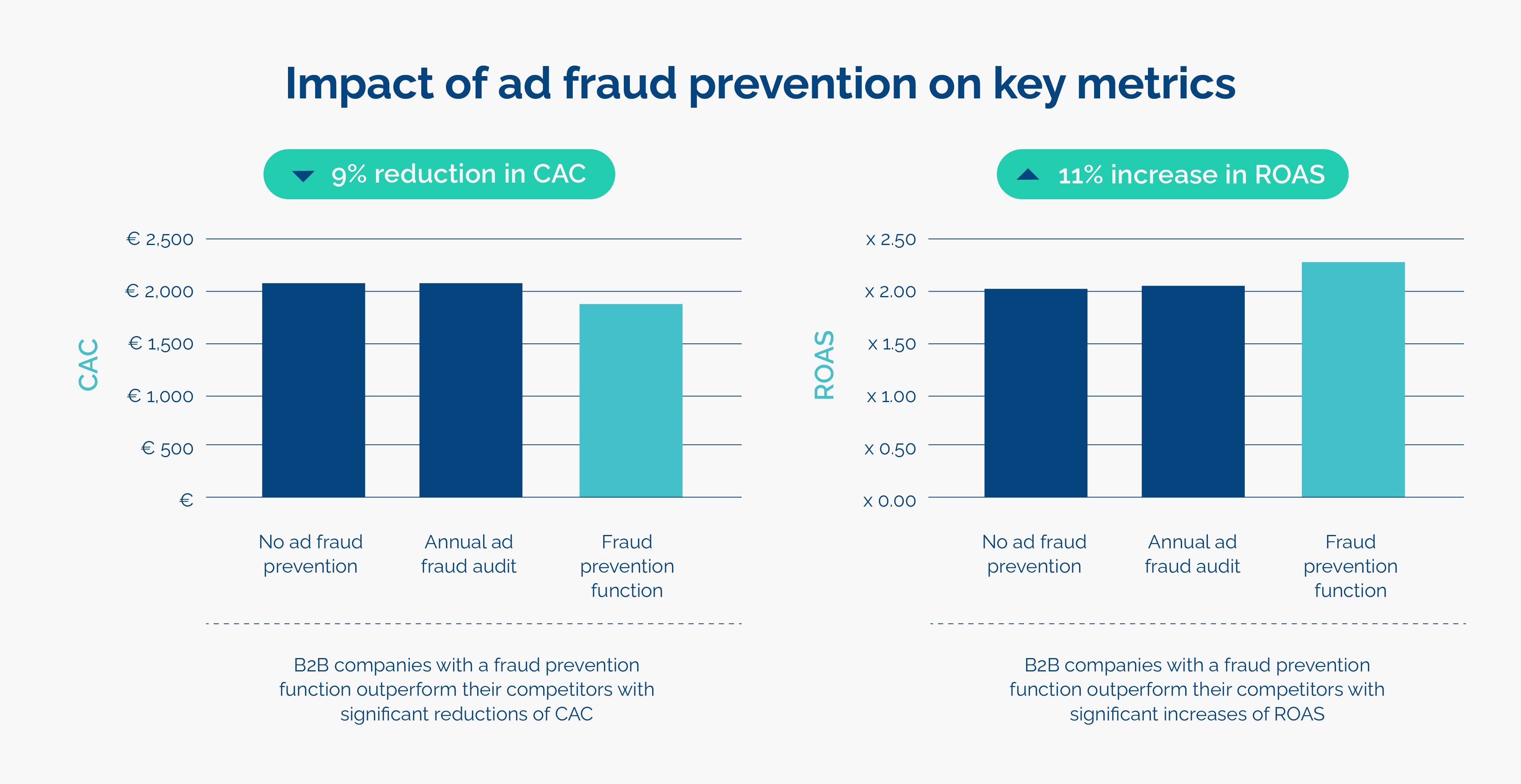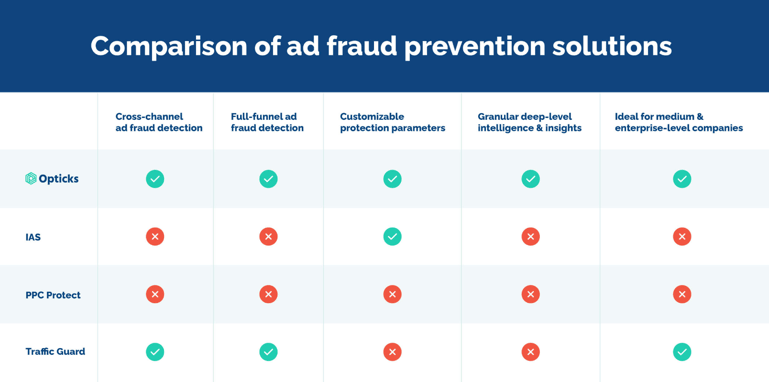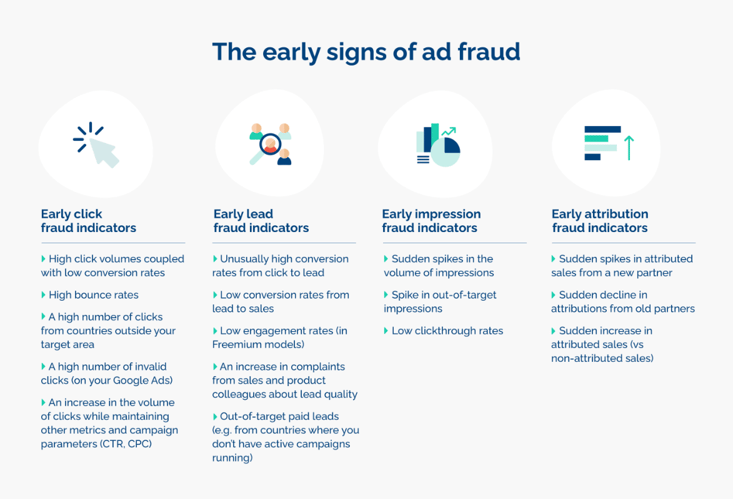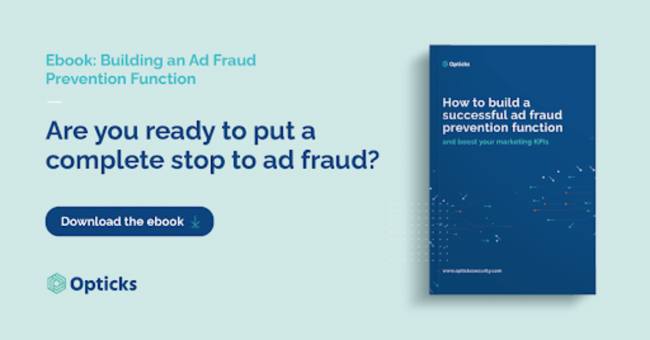The Essential Guide to Ad Fraud Prevention

 By
Eduardo Aznar
·
12 minute read
By
Eduardo Aznar
·
12 minute read
Simply put, your advertising campaigns will be more successful with an ad fraud solution. After all, it's everywhere. All channels, platforms, partners, industries, verticals, and geographies are vulnerable to the many types of ad fraud that exist -- and fraudsters are still finding new, sophisticated ways to drain your ad budgets every day.
Ad fraud is also not reversible. Once the damage is done, you’re rarely able to circumvent its effects. The only way of truly dodging the devastating consequences of ad fraud is by preventing it in the first place.
But you don’t need to prevent complicated ad fraud schemes alone. To help you get started, we’ve put together this essential guide to ad fraud prevention that contains all the advice you need to ensure you can run successful, fraud-free campaigns.
- What is ad fraud prevention?
- Why do I need to prevent ad fraud?
- What are the main ad fraud prevention methods?
- How to prevent ad fraud effectively and efficiently
- What are the top ad fraud prevention companies?
- How to choose the right ad fraud prevention solution
- How Opticks can help you prevent ad fraud
What is ad fraud prevention?
Ad fraud prevention is the proactive action of assessing the validity of the traffic to ad campaigns in an effort to intercept and block fraudulent activity and traffic before they can cause any damage.
Clicks, conversions, and leads are evaluated in real-time to determine whether ad fraud is present and if it is, to stop it from occurring. Ad fraud prevention is performed by specialist solutions that can automatically prevent fraudulent activity from entering ad campaigns and campaign data.
While ad fraud detection helps you identify fraud, ad fraud prevention goes one step further and actually stops it before it harms your campaigns. That's why prevention is much more important for advertisers.
Early-stage indicators of ad fraud that advertisers need to be aware of include:
Why do I need to prevent ad fraud?
Ad fraud isn’t a localized crime. In fact, the findings from our 2022 Ad Fraud Report show that bad actors aren’t at all choosy when it comes to deciding who to defraud, meaning that all industries, verticals, and geographies are vulnerable.
Plus, it doesn’t matter which advertising channels you use -- our data demonstrates that all channels are susceptible to ad fraud (with indirect affiliate, native, and programmatic marketing being the most susceptible).
As worldwide digital ad spending reaches new heights (it’s expected to surpass $571 billion in 2022 alone), fraudsters have more opportunities than ever before to exploit advertisers without ad fraud prevention measures in place.
Let’s take a look at the benefits of ad fraud prevention for advertisers:
Your ad budget is protected
Without solid ad fraud prevention, you’ll continue to waste money on investing in fake clicks and leads that will never convert. Essentially, this means that fraudsters are capturing a large share of your budget that could be spent on driving real revenue from real users.
You can boost your return on ad spend and minimize customer acquisition costs
Ad fraud prevention helps bolster your business by protecting return on ad spend (ROAS) rates from plummeting and customer acquisition costs from skyrocketing.
Without ad fraud prevention, our research shows that your ROAS rate will reduce by 11% and your customer acquisition costs will increase by 9%.

You can ensure you have accurate data for decision making
The presence of ad fraud completely distorts your ad campaign data, results, and analytics, and pollutes your CRM with fake information. This ultimately impairs your decision-making, your ability to target and retarget the right users, and your ability to manage resources since the data you’re working with is contaminated.
You can hit your targets
As a result of your polluted data (and the consequent inability to make accurate decisions and strategize correctly), you’ll often be unable to reach your campaign and revenue targets -- both within your team and the wider organization. Ultimately, spending money on fraudulent traffic is a huge blockade to being able to reach your goals.
What does all of this tell us? Proactive ad fraud prevention is key in helping you achieve your goals, a great return on ad spend, and decreased customer acquisition costs.
In fact, implementing a holistic ad fraud prevention process -- which involves placing the prevention of ad fraud at the core of a business and its growth strategy -- has been shown to bolster and improve your key business metrics overall.
👉 Read more: 2022 Ad Fraud Report: Summary of Key Findings for Advertisers
What are the main ad fraud prevention methods?
Specialized solutions facilitate the ad fraud prevention function, but not everyone uses the same methods. Here, we take a look at some of the most common ad fraud prevention methods.
Manual/semi-manual methods
IP blocking or blacklisting is a method that involves preventing specific IP addresses and servers from gaining access to websites and therefore ads. This can be done manually, and some solutions maintain their own blacklists to prevent all clicks and installs from blacklisted sources.
This method of prevention, however, severely lacks the flexibility needed to block fraudsters’ techniques. Manual blacklisting is outdated and isn’t robust enough to prevent ad fraud, nor analyze traffic carefully enough to redeem false positives.
Rules-based prevention
Rules-based anti-fraud prevention solutions use predefined heuristic rules to identify ad fraud patterns. Essentially, if traffic or user behavior falls outside of the parameters’ standard range defined by a set of rules created by an expert, it will be flagged and blocked.
The rules with this method usually have thresholds and targets. For example, heuristic rules might look something like this:
“Block users coming from Asia and Europe time zones in US-targeted campaigns”
“Block users coming from Apple-based browsers in Windows platform”
There are also location-based rules, which would block transactions from locations outside of specified geographies.
However, used alone, there are limitations to the rules-based prevention method. Since it is limited by two-dimensional thresholds, each rule is essentially limited to a “yes” or “no” decision without room for analysis, and, once fraudsters figure out your rules, they’ll find ways of circumventing them.
Statistical analysis
Some ad fraud solutions employ statistical analysis to estimate how likely it is that user activity is fraudulent. This involves using methods like calculations on distributions and means deviation to determine whether traffic is “usual” or contains unusual patterns.
Statistical analysis models often analyze the following variables to detect ad fraud:
- Volume of traffic
- Conversion rates
- Distribution of fingerprints
However, there are plenty of industry-specific statistics that can be taken into account when designing the systems that execute statistical analysis, such as time between conversions, daily distribution, or deviation between different traffic sources, among many others.
Related techniques
Anomaly-based method
The anomaly-based method utilizes statistical analysis along with historical data to assess traffic for unusual occurrences and anomalies such as spikes in traffic and sudden surges in clicks.
Behavioral detection and prevention
Behavioral detection and prevention methods predict whether user behavior is real or not based on the mechanism’s understanding of human-like behaviors. For this reason, it’s a useful tool for detecting bad bot behavior.
This method uses its knowledge of how users usually behave to determine whether the user is legitimate, preventing ad fraud before it has a chance to destroy campaigns.
Some of the common user behaviors that are analyzed using this detection mechanism include:
- Scrolling behavior
- Keystrokes
- Mouse dynamics and movements (non-linear/randomized/patterned)
- Mouse clicks (identifying rhythms)
- Number of requests during a session
Related techniques
Signature-based
Signature-based solutions detect suspicious behavior (including traffic, clicks, and impressions) by comparing patterns with monitored activity to determine whether the behavior is legitimate.
Honeypot-based
The honeypot-based method uses a “bluffing” tool that contains a custom script embedded into advertising forms to help identify ad fraud and bot activity.
The “honeypot” is an additional field that is invisible to the user. Bots, however, are unaware of the bluff field and fill it in regardless which then activates a rejection process to prevent fraudulent attempts.
Machine learning
Machine learning is the most helpful technique when it comes to tackling fraud as it evades statistical and rule-based detections resulting from large volumes or highly sophisticated bots.
Machine learning extracts patterns and identifies relationships within large datasets and uses historical data to classify new data to predict the likelihood of ad fraud. Sophisticated ad fraud techniques can easily hide within large volumes of traffic, but machine learning can identify patterns by examining multiple variables rapidly.
As the engine is fed more data, machine learning algorithms begin to self-train themselves to detect different patterns with little human intervention. This is important as fraudsters become increasingly sophisticated since many triggers within data are undetectable by the human eye.
What’s more is that machine learning algorithms can also be highly customized to each organization’s requirements and parameters, meaning that prevention is even more accurate.
How to prevent ad fraud effectively and efficiently
Preventing ad fraud is not a one-person job. In fact, there are several steps that all organizations need to take to effectively eliminate ad fraud. Here are the three most important:
1. Choose an ad fraud prevention solution
A solid anti-ad fraud solution is key to the rest of your fraud prevention activities. They’re designed to detect and block ad fraud before it occurs and help advertisers optimize their campaigns, increase conversions, and protect their ad spend.
To help you choose the right ad fraud prevention solution for your needs, we explore several solutions in the next section of this guide.
2. Set up an ad fraud prevention process
The success of your ad fraud prevention strategy doesn’t just rely on the implementation of an anti-fraud solution. An ad fraud prevention process places the prevention of ad fraud at the center of a business’s growth strategy -- after all, ad fraud significantly hampers your ability to hit your growth targets.
An ad fraud prevention process is the combination of three things that enable businesses to prevent ad fraud:
- Resources (people and systems)
- Timings
- Agendas
The goal is to align siloed systems, departments, stakeholders, and individuals to tackle ad fraud as a whole, rather than relying on fragmented efforts.
💡 Learn more about how to set up your own ad fraud prevention process here.
3. Establish an ad fraud prevention committee
As part of the fraud prevention process, an ad fraud prevention committee is made up of a group of individuals responsible for overseeing the prevention of ad fraud within an organization.
These individuals will belong to several departments and functions, including marketing, sales, finance, and growth and analytics teams, and each will have its own specific set of responsibilities.
Together with your ad fraud prevention solution and fraud prevention process, the committee enables you to establish and optimize the processes that ensure the continuous improvement of prevention tactics.
💡 Discover how to establish your own ad fraud prevention committee here.
What are the top ad fraud prevention companies?
When it comes to executing your anti-fraud strategy, choosing the right ad fraud prevention solution is one of the most important decisions you’ll make.
While there are many ad fraud prevention solutions on the market, each of them specializes in different prevention methods and concentrates on different channels and industries. Plus, since your business has its own unique needs and growth objectives, the company you choose needs to offer a robust solution.
Here, we’ve put together an overview of four different companies to give you an idea of what they offer, and which can provide you with the holistic ad fraud prevention features you need.
Opticks
Opticks is a cross-channel and full-funnel ad fraud prevention solution.
Here’s what this means: Many ad fraud prevention solutions only provide ad fraud protection at certain stages of the advertising funnel. Opticks, however, prevents ad fraud across the complete advertising funnel. In short, Opticks can differentiate between legitimate users and fraudulent behavior at the view, click, lead, and attribution levels.
As a holistic solution, Opticks is fully customizable and can analyze traffic across any advertising channel on any device and any browser. The company has developed its own proprietary technology that prevents even the most advanced fraud techniques from damaging campaigns, including its state-of-the-art machine learning engine which stays two steps ahead of fraudsters’ tactics.
Opticks' feature set
Opticks’ rich catalog of features helps businesses prevent ad fraud across the whole advertising funnel and all channels. Its key features include:
- Cross-channel ad fraud prevention: No matter which channel you use, or how many, Opticks provides complete coverage for all of your marketing and advertising activities. The solution also analyzes all traffic sources across all channels, including:
- Social media: Facebook Ads, Instagram Ads, etc.
- Search engines: Google Ads, Microsoft Bing, Yahoo Ads, etc.
- Programmatic
- Affiliate: Affiliate or ad networks, agencies
- Native advertising
Since Opticks also prevents fraud derived from organic traffic, the platform is suitable for all use cases.
- Full-funnel prevention: Opticks prevents ad fraud at every stage of the advertising funnel, no matter where ad fraud is present. From PPC campaigns, display ads, and lead generation campaigns to ads within mobile apps, Opticks is built to prevent a huge scope of fraud types that target different parts of the advertising funnel. This includes bot traffic, geo-masking, click farming, click spamming, pixel stuffing, data center traffic, non-visible ads, and clickjacking.
- Advanced fraud intelligence: The platform provides granular insights and metrics that can support and direct your growth efforts. Its fraud visualization functions enable you to access deeper insights such as ad fraud by origin (channels and partners), vehicles of fraud (devices and browsers), geographies, and timestamps.
Opticks also provides multiple additional features to bolster ad fraud prevention, including:
- Customizable security parameters: Since every business has different marketing models, acquisition channels, and partners, Opticks allows businesses to customize their security parameters in real-time, including the triggers that should be considered fraud.
- Robust methodology: Opticks combines the best of the best prevention methods: The precision of rules-based fingerprinting with the scalability of statistical analysis and machine learning detections.
Opticks’ ideal clients
As a full-funnel solution, medium to enterprise-level organizations will benefit from Opticks’ ad fraud prevention functionalities no matter their size or where they operate within the digital advertising space. In particular, Opticks is the ideal ad fraud prevention solution for:
Advertisers: Opticks’ prevention of ad fraud across SEM, programmatic, affiliate, and native channels helps advertisers reach their revenue targets and supports their growth goals. Plus, they can also access deeper insights into their ad performance and make data-driven decisions.
Agencies and networks: With Opticks’ holistic prevention solution, agencies and networks can build more credibility by guaranteeing the highest quality traffic to their advertising partners, enabling them to partner with leading advertisers and outperform their competitors.
Telecoms: Opticks enables telecoms to guarantee the quality of their traffic and protect mobile users by blocking bots and malicious traffic sources -- and therefore unwanted subscriptions. This also reduces the number of complaints from customers deriving from unwanted subscriptions, thus improving overall NPS and ROI.
IAS
IAS is a digital ad verification solution that provides only impression-based fraud prevention brand safety features.
Focused solely on the top of the advertising funnel, IAS’ goal is to ensure that organizations’ ads are only seen by legitimate users and shown on safe and appropriate websites.
The solution is a great choice for businesses interested in protecting their brand image. However, since IAS can only detect impression fraud, the solution lacks holistic, full-funnel capabilities. Since performance marketers continue to invest more and more resources at the bottom of the advertising funnel, IAS isn’t suitable for businesses who want a solution that can prevent ad fraud from all of their campaigns and channels.
IAS’s ideal clients
IAS offers a variety of solutions to a range of customer types, including brands and agencies. However, since it only provides prevention for top-of-funnel impression fraud and brand safety, IAS is mostly suitable for large, enterprise-level companies. In particular, IAS is a good choice for those in the fast-moving consumer goods (FMCG) industry, the automotive industry, and businesses that invest heavily in video and impression-based advertising.
PPC Protect
PPC Protect is a click fraud prevention solution for pay-per-click (PPC) campaigns that analyzes clicks in real-time to determine their validity and evaluates website visitors to build detailed profiles and identify fraudulent behavior.
PPC Protect, as its name suggests, only protects against ad fraud in PPC Google campaigns, and does not provide the necessary cross-channel or full-funnel detection services needed to help businesses prevent ad fraud across all of their campaigns and channels.
PPC Protect’s ideal clients
PPC Protect only provides PPC detection functionality. Therefore, its ideal clients are small advertisers that invest solely in PPC campaigns.
TrafficGuard
TrafficGuard is an invalid traffic detection solution that prevents ad fraud across a range of channels and campaign types.
Like Opticks, TrafficGuard can detect click and lead fraud. Although TrafficGuard can detect impression fraud, it does not provide PPC ad fraud prevention and general ad fraud prevention in one single product, meaning users will need to invest in several solutions to protect all of their advertising channels.
TrafficGuard’s ideal clients
TrafficGuard offers ad fraud prevention for brands, apps, agencies, and ad networks.

How to choose the right ad fraud prevention solution
With so many options to choose from, you need to have a solid evaluation process in place to ensure that you select the right solution for your needs. Below, we go through seven features and capabilities you’ll need to consider when assessing each ad fraud prevention solution.
1. Core anti-ad fraud features
Check that each solution offers the core anti-ad fraud features you need. These include:
- Cross-channel and full-funnel fraud prevention
- Multi-threat detection
- Customizable security parameters
- Advanced fraud intelligence
2. Availability of expert advice and onboarding
You’ll need skilled ad fraud specialists to help onboard your team to the system, as well as access to expert knowledge and advice and an intuitive system. Check that the solution and provider can offer the following:
- Side-by-side onboarding of your teams
- An easy, low-tech environment to enable your teams to access prevention measures comfortably
3. Proven technological performance
Verify that the solution has the technology needed to operate the features it offers and your requirements. A robust ad fraud prevention solution should offer:
- Minimal latency
- Guaranteed uptime SLA
- GDPR compliance
4. Potential cost savings to be made by implementing the solution
Preventing ad fraud prevents your budgets from being squandered. However, an ad fraud prevention solution should also help you enjoy other cost savings by redirecting resources to other valuable activities. Importantly, the solution should be so robust that you don’t need to hire additional anti-fraud staff to monitor your campaigns.
Other features that aid cost savings include:
- Free software updates and improvements
- Flexible payment for overage volumes
5. Risk and commitment levels involved in adopting the solution
Make sure that before you adopt a solution, you look into each provider’s subscription models and termination policies thoroughly to avoid any unnecessary contract tie-ins or dubious terms and conditions.
In particular, providers should deliver:
- A quick set-up time
- The possibility to do a proof of concept
6. How well the solution is future-proofed
The solution you choose needs to be able to support your business and growth goals. If the solution isn’t equipped to scale alongside your organization, you can expect to spend more money and time adopting another solution in the future.
Ensure that the solution can provide:
- Fast innovation at scale
- Free software improvements and updates
7. The social proof of each ad fraud prevention solution
Before making a final decision, do your due diligence and check that the solution has been tried and tested by other companies -- in particular, organizations in similar industries and locations – and has received positive feedback.
Check out the solution’s:
- Relevant ratings and reviews from real users
- Case studies and client base
💡 Read more: Complete Buyer’s Guide to Ad Fraud Prevention Solutions
How Opticks can help you prevent fraud
As a full-funnel, cross-channel solution, Opticks has an impressive track record of helping clients from a range of industries, backgrounds, and business models prevent ad fraud from wrecking their campaigns.
As ad fraud continues to evolve into more sophisticated realms, only Opticks has the experience, expertise, and technology to keep threats at bay and protect your budgets by proactively preventing ad fraud. Our holistic, end-to-end solution ensures that all of your campaigns and advertising efforts are safeguarded from day one, meaning you can dedicate precious resources to what you do best – optimizing your advertising strategy.
To learn more about how the expert team at Opticks prevents ad fraud before it can ever become a problem, contact us and schedule a free demo today.


